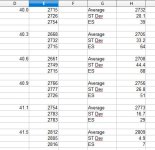I always and I do mean always start at minimum.
I used online Hogdon load info once for my .260 Rem and the first shot starting at the minimum load had a primer back out and the velocity was up there in the 6.5 284 range. Packed the rifle up, came home and double checked the load info. Did some more research and Hogdon had the .260 using 3.0 gns over the same powder and bullet for a 6.5 CM. For those not familiar with those two cartridges they have almost identical case volumes.
I pulled the remaining bullets and reloaded using the 6.5 CM data and life was good. If I had started in the middle or the top of that published load there is no doubt I would have blown that rifle up
I used online Hogdon load info once for my .260 Rem and the first shot starting at the minimum load had a primer back out and the velocity was up there in the 6.5 284 range. Packed the rifle up, came home and double checked the load info. Did some more research and Hogdon had the .260 using 3.0 gns over the same powder and bullet for a 6.5 CM. For those not familiar with those two cartridges they have almost identical case volumes.
I pulled the remaining bullets and reloaded using the 6.5 CM data and life was good. If I had started in the middle or the top of that published load there is no doubt I would have blown that rifle up

